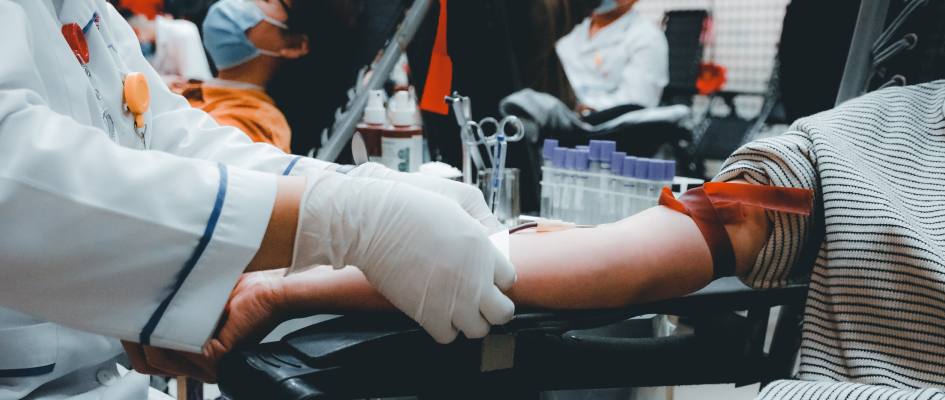The tears of a mother cannot save her ailing child. But your blood can!
Wonder why we started this blog with such a hard-hitting and emotionally touching statement? Well, our sole and soul purpose is to create awareness about that all important ‘thin red line’ between life and death which most of us tend to ignore. Blood donation!
That said, we’d first like to thank all those who have donated blood from the bottom of our heart! Thank you for giving someone the gift of life!
Remember, when you donate your blood, you donate it for a reason, and the reason is life!
This World Blood Donor's Day let’s give you a detailed insight of the whole blood donation process, what are the different blood types and things blood donors should keep in mind to maintain their health and well-being.
First of all, know that any healthy adult can donate, and besides the amount of blood taken from you is just a minuscule ‘pint’ which has little or no aftereffects. In fact, giving blood is good for your body as your body replaces the blood given with fresh blood!
That said, there are certain tips to follow before the day of your donation.
- Get a clean chit from the doctor: Check with the doctor if you are fit enough physically and mentally to donate blood.
- Eat properly and drink liquids: Eating well and drinking water or juices before donating will help to keep your blood sugar levels stable and reduce the drop in your blood pressure. This will help reduce the slight dizziness that you may feel after giving blood.
- Avoid strenuous exercise: There’s no harm if you skip the gym for a day. Because you tend to burn calories and lose fluids during a vigorous workout. This could also result in dizziness after blood donation.
- Wear loose fitting and comfortable clothes: Preferably wear a half-sleeved shirt or tee, for after all the blood needs to be taken from the vein in the inner part of your elbow, so half sleeves makes it easily accessible. Also ensure the rest of your clothing is not too tight so that your blood can flow freely.
- Distract yourself: Though blood donation is a rather painless affair, except the initial prick of the needle that goes into your vein, that feels more or less like a mosquito bite! It is normal to feel nervous. So, bring along a friend with a great sense of humour to laugh your wits out during the whole process, or better still, listen to your favourite foot-stomping tracks on your I-pod!
Congratulations! You’ve taken the first step to be a life savour. So, here’s what happens to your blood after you’ve donated it, till the time it reaches the person in need:
· During blood donation, about 1 pint of blood is collected.
· Your blood is kept on ice before being taken for processing in the lab.
· At the lab, your Red cells and platelets are leuko-reduced, which means your white cells are removed in order to reduce the possibility of the recipient having a reaction to the transfusion.
· A dozen tests are performed, to establish the blood type and test for any infectious diseases.
· When test results are received, units suitable for transfusion are labelled and stored.
· Your blood will be available to be shipped to hospitals 24 hours a day, 7 days a week.
· When an ill or injured patient arrives at a hospital, doctors determine whether the patient requires a transfusion and, if so, which type.
· Blood transfusions are given to patients in a wide range of circumstances, including serious injuries such as in a car accident, surgeries, childbirth, cancer and other blood disorders.
You should already know that all of us have a different blood group. And most blood groups need to use the blood from the same blood group. So, first let’s learn a little about the ABC’s of blood groups shall we😊!
There are 8 blood groups in toto:
· A positive
· A negative
· B positive
· B negative
· AB positive
· AB negative
· O positive
· O negative
Now let’s understand which blood group can mixed be with which blood group:
In order for a blood transfusion to be safe and effective, it’s important for the donor and the recipient to have to have the same blood group! For example, people with blood group A can safely get group A blood, and people with blood group B can receive group B blood.
That said, even blood groups have a trump card up their sleeve:
O negative is considered the safest to give to anyone in a life-threatening emergency or when there’s a limited supply of the exact matching blood type. That's because type O negative blood cells don't have antibodies.
It’s no wonder that people with with O negative blood are called “universal” donors because they can donate blood to anyone with any blood type.
Now that we’ve told you all you need to know about blood donation. Let’s sum up our blog with one statement to ponder over. Always remember…
The elixir of life lies within you!



